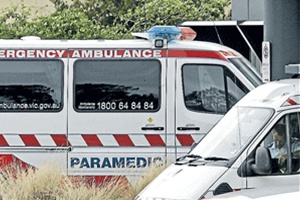PARAMEDICS are spending more than 900 hours a month waiting to transfer patients to wards at the western suburbs’ two biggest hospitals, delaying the paramedics in responding to other jobs.
Data obtained under freedom of information by Williamstown MP and opposition parliamentary secretary for health Wade Noonan shows the time from when an ambulance arrives at the hospital to when patients are handed over to the hospital, known as ramping, is growing each year.
Ambulances were ramping for 380 hours a month at Sunshine hospital in the nine months to March this year, up from 313 hours a month in 2010-11. At Footscray, paramedics waited with patients on trolleys for 540 hours a month to March, compared to 433 hours a month the previous year.
Mr Noonan said the health system was constantly in gridlock. “We need our ambulances available to attend emergencies, not sitting in queues at hospitals. Longer ramping times at hospitals mean there are fewer ambulances available to respond to life-threatening emergencies.”
The state government’s 2012-13 budget papers reveal that ambulance response times for life-threatening emergencies are also lengthening.
The proportion of emergency (code 1) incidents responded to within 15 minutes across the state is expected to be just 74.7per cent for the 2011-12 period, more than 10per cent lower than the government’s target.
Ambulance Victoria regional services general manager Tony Walker said the time taken to transfer patients at hospitals could impact on the ability to respond to triple-0 calls. “Any delays which affect our capacity to serve the community are frustrating”. Ambulances take about 1750 patients to hospital every day, with the number of patients transported increasing from 616,982 in 2009-10 to 639,735 in 2010-11.
Mr Walker said the service was always looking for ways to minimise the time required for patients to be in hospital wards, including a pilot program of transferring of appropriate low-acuity patients into emergency department waiting rooms. In cases where patients may call an ambulance in the hope they receive treatment sooner, Mr Walker warned that “patients who travel to hospital by ambulance still need to be triaged at hospital; if they don’t require urgent treatment they don’t get seen any quicker.” Health Minister David Davis told the Weekly the previous government had kept that data secret and would not release the transfer times.
Mr Davis said real-time data showing the status of hospital emergency departments was available, helping patients to see which hospitals were under heavy load and how long it would take to get treatment.
He also pointed to measures to increase capacity at hospitals, including $15.1million for Sunshine hospital’s intensive care unit, to move people out the emergency department. “The ED bears the brunt of that [demand] and if people can’t be moved into the general hospital there’s a challenge there. Capacity is part of it, the flow is part of it; having information in the public domain is also part of it.”








